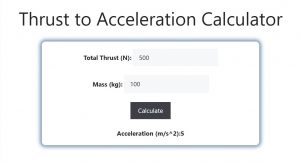About Thrust to Acceleration Calculator (Formula)
The Thrust to Acceleration Calculator is a valuable tool in fields such as aerospace engineering, automotive design, and physics. It allows users to determine the acceleration of an object when a specific thrust is applied. Understanding the relationship between thrust and acceleration is crucial for engineers and designers when developing vehicles, aircraft, or any system that involves motion. By using this calculator, one can gain insights into the performance characteristics of various systems under different conditions.
Formula
The formula for calculating acceleration from thrust is: A = TH/m, where A is acceleration, TH is thrust, and m is the mass of the object.
How to Use
Using the Thrust to Acceleration Calculator is simple:
- Measure Thrust: Determine the amount of thrust applied to the object in newtons (N).
- Determine Mass: Measure the mass of the object in kilograms (kg).
- Input Values: Enter the thrust value and the mass into the respective fields.
- Calculate Acceleration: Use the formula to divide thrust by mass to find acceleration.
- Read Result: The resulting value will represent the acceleration in meters per second squared (m/s²).
Example
For example, if an engine produces a thrust of 500 N and the mass of the object is 100 kg, the calculation would be as follows:
- Thrust (TH): 500 N
- Mass (m): 100 kg
Using the formula:
A = TH / m
A = 500 N / 100 kg
A = 5 m/s²
In this case, the acceleration produced by the thrust would be 5 meters per second squared.

FAQs
- What is thrust?
- Thrust is the force that propels an object forward, typically generated by engines or motors.
- How is acceleration defined?
- Acceleration is the rate of change of velocity of an object, measured in meters per second squared (m/s²).
- What units are used in the Thrust to Acceleration Calculator?
- Thrust is measured in newtons (N), mass in kilograms (kg), and acceleration in meters per second squared (m/s²).
- Can this calculator be used for any object?
- Yes, it can be applied to any object as long as you know the thrust and mass.
- What factors can affect thrust?
- Factors include engine efficiency, aerodynamic design, and environmental conditions.
- Is this calculator useful in space travel?
- Absolutely! Understanding thrust and acceleration is critical in rocket science and space exploration.
- How do I increase acceleration?
- You can increase acceleration by increasing thrust or decreasing the mass of the object.
- What happens if the mass is too high?
- If the mass is too high relative to the thrust, the acceleration will be low, resulting in slower movement.
- Is there a maximum thrust limit?
- Yes, each engine or propulsion system has a maximum thrust it can produce.
- How do I convert thrust from pounds to newtons?
- To convert pounds to newtons, multiply the pound value by 4.44822.
- What role does friction play in acceleration?
- Friction can oppose thrust, reducing the effective acceleration of the object.
- Can I use this calculator for vehicles?
- Yes, it’s useful for calculating the acceleration of cars, trucks, and other vehicles.
- How is this calculator used in aerospace?
- It helps in designing aircraft and rockets to ensure they meet performance requirements.
- Can I apply this to electric vehicles?
- Yes, electric motors also produce thrust, and this calculation applies to them as well.
- What is the importance of knowing acceleration in engineering?
- It helps engineers design systems that meet speed and performance specifications.
- Does altitude affect thrust?
- Yes, thrust can vary with altitude due to changes in air density.
- How do I calculate thrust?
- Thrust can be calculated using various formulas depending on the system, such as T = F + D, where F is force and D is drag.
- What is the relationship between thrust and speed?
- Generally, as thrust increases, speed increases, but other factors such as drag must also be considered.
- Can the calculator handle variable thrust?
- This basic calculator assumes constant thrust; variable thrust requires more complex calculations.
- What safety considerations should I keep in mind?
- Always consider the structural limits of materials and components when applying thrust to ensure safety.
Conclusion
The Thrust to Acceleration Calculator is a powerful tool that aids in understanding how thrust influences acceleration in various applications. By mastering this calculation, engineers, designers, and enthusiasts can enhance their knowledge of motion dynamics and optimize their systems accordingly. With the information provided in this article, users can confidently utilize the calculator to make informed decisions about performance and design in a variety of fields.